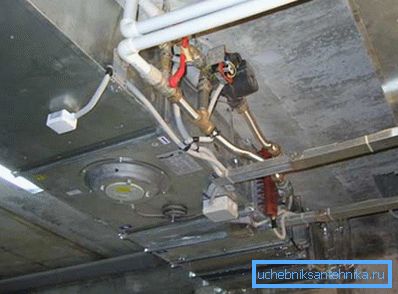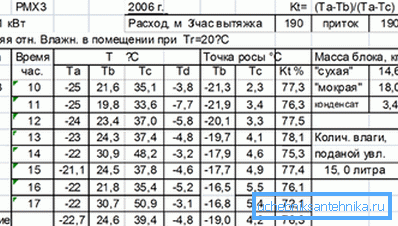Ventilation test: test values and regulatory requirements
What is the test of the ventilation system? What parameters are evaluated? Are there any regulatory documents regulating the arrangement of ventilation systems and the procedure for their verification?
Let's try to answer these questions.

List of documents
From a fairly extensive list of documents related to ventilation, we have to examine two main ones.
- In SNiP 3.05.01-85 sets out the general requirements for the device ventilation.
- In GOST 12.3.018-79 described technology, which are aerodynamic tests of ventilation systems.
Important: the act of comprehensive testing of ventilation systems is issued on the basis of both measurements of the actual performance of the system and visual inspection with verification of the parameters of the ventilation equipment with the stated ones.
According to the test results, the owner is issued a ventilation passport.
Why is it needed?
- A passport is a document officially registering the equipment purchased by you - even if at the time of purchase it did not have certificates of compliance with Russian standards.
- In addition, the document will serve as a weighty argument in any disputes with supervisors. In case of fires, smoke and other troubles, the owner will always be able to prove that they were not caused by the inconsistency of the structure and performance of the ventilation system with the applicable standards.
Let's turn to the requirements of regulatory documents.
Requirements
SNiP 3.05.01-85
Air ducts, in which dew fallout is possible, are laid with a constant inclination to the drainage of 1 - 1.5 cm per meter of length. The longitudinal seams of such boxes are located only in their upper part (read also the article “Examination of ventilation” for timely detection of problems and contamination).
Gaskets between the flanges may be extended outside the flange only.

Gasket material is also regulated.
- At air temperatures up to 70C, you can use foam rubber, foam rubber, thick rubber seals or mastic polymer harness.
- At temperatures above 70C asbestos cardboard or asbestos tow are used.
Nuance: for the production, the technology of which implies air pollution by acid fumes, only acid-resistant rubber is used.
Gerlen (a sealing tape made of rubber-like material), sealing mastics and heat shrinkable cuffs can be used to seal the socket joints.
All bolts must be tightened on the flange. Nuts must be on one side of the flange; with its horizontal arrangement, the nuts are usually located at the bottom. The instruction is connected with banal safety: a bolt is heavier than a nut and, if dropped from a great height, can cause more serious injuries.
Testing of ventilation systems, among other things, involves a visual check of the pitch of the ducts. What should it be?
| Duct Type | Maximum spacing between attachment points (hangers or supports), m |
| Flangeless with the largest size up to 400 mm | four |
| Flangeless with the largest size over 400 mm | 3 |
| Flanged with the largest size up to 2000 mm | 6 |
| Vertical | four |
Nuance: when the ceiling height in the building is up to 4 meters, it is recommended to fix vertical ventilation shafts in the ceiling.
The air ducts are connected to the fans with flexible inserts that prevent the transmission of vibration.

Radial fans should be installed on anti-vibration bases on anchors. The vibration isolators themselves, when installed on the floor or foundation, do not require fastening, but it is necessary to fasten them to the metal structures.
The axes of the fans and electric motors should be strictly coaxial or parallel (depending on the method of transmission of torque).
All potentially dangerous elements of the ventilation system (couplings, belts, open suction nozzles) are covered with protective covers and nets.
GOST 12.3.018-79
How, according to the document, aerodynamic tests of ventilation systems are performed?
Measurement points
- To measure the pressure and flow rate, sections are selected that are located no closer than 6 hydraulic diameters after the flow perturbation point (turn, valve, grille, etc.) and no closer than 2 hydraulic diameters to it. The cost of non-compliance with this rule is a serious distortion of the measurement results due to turbulence.

Reference: for a round duct hydraulic diameter equal to the inner diameter. For a rectangular, it is calculated as 2AB / (A + B), where A and B are sides of the inner section of the duct.
- It is permissible to place the measuring point (measuring section) at the point of sudden narrowing or widening of the channel. Moreover, its area is taken equal to the smallest cross-sectional area in the constriction.
Equipment
What equipment is used for individual tests of ventilation and air conditioning systems?
- A combined pressure receiver is used to measure the dynamic pressure in a stream at a speed of over 5 m / s and the static pressure in a steady stream.
- A full pressure receiver is needed, as the name implies, to measure the total pressure in fast (over 5 m / s) flows.
- Differential pressure gauge and pressure gauge are used to measure pressure drop.

- Anemometer (thermo-anemometer) - to measure the speed of slow (up to 5 m / s) air flow.
- Barometer - for measuring the pressure of the environment. This is necessary in order to assess the flow of air when ventilation is working.
- Mercury thermometer or thermocouple - to measure air temperature.
- Psychrometer - to measure the level of humidity.
Nuance: in measurements carried out in dusty streams, the design of the devices should provide for their simple cleaning - with their own hands, with a brush, or with a stream of compressed air from the compressor.
Test order
Tests are conducted no earlier than 15 minutes after the start of ventilation; During this time, all the basic parameters of pressure, velocity, temperature and humidity stabilize.
What exactly is measured?
- The air pressure in the room.
- The temperature in the duct.
- The temperature in the room.
- Dynamic flow pressure.

- Static pressure at the same point of flow.
- Total pressure at the same point.
- The time that the anemometer is in the plane of the measured cross-section of the flow, and the change in its readings.
Security
The only requirement related to safety is that the measurement process should not lead to the formation of hazardous or explosive gas concentrations.
Documenting
On the basis of the measurements and their processing, a protocol of aerodynamic tests of ventilation is compiled, where all the parameters taken are entered. In addition to recording measurements, the act of individual testing of ventilation equipment includes the results of visual inspection and verification of the actual characteristics of the equipment with the stated.

To be subject to activation:
- For fan - type, impeller diameter, flow rate and total flow pressure, revolutions and pulley diameter.
- For electric motor - type, power, speed, method of transmitting torque and pulley diameter.
- For air conditioners and heaters - type, coolant circulation scheme, its type and test results by working pressure.
- For filters - throughput, percent trapping and pressure drop.
- For humidifiers - type, air flow, pressure before the sprayer, revs and diameter of the wheel of the sprayer and motor power.
The act of testing the ventilation system, while complying with all technical requirements and deviating the real characteristics from the project by no more than + 10%, serves as the basis for issuing a ventilation passport.

Conclusion
We hope that we could answer the questions that have accumulated in the reader in the area of regulatory requirements and test procedures (see also the article “Automation for ventilation: functions, features, capabilities”).
As always, the video in this article will offer additional information. Successes!